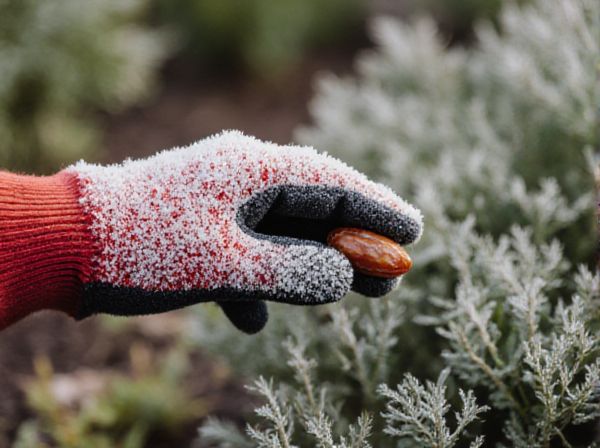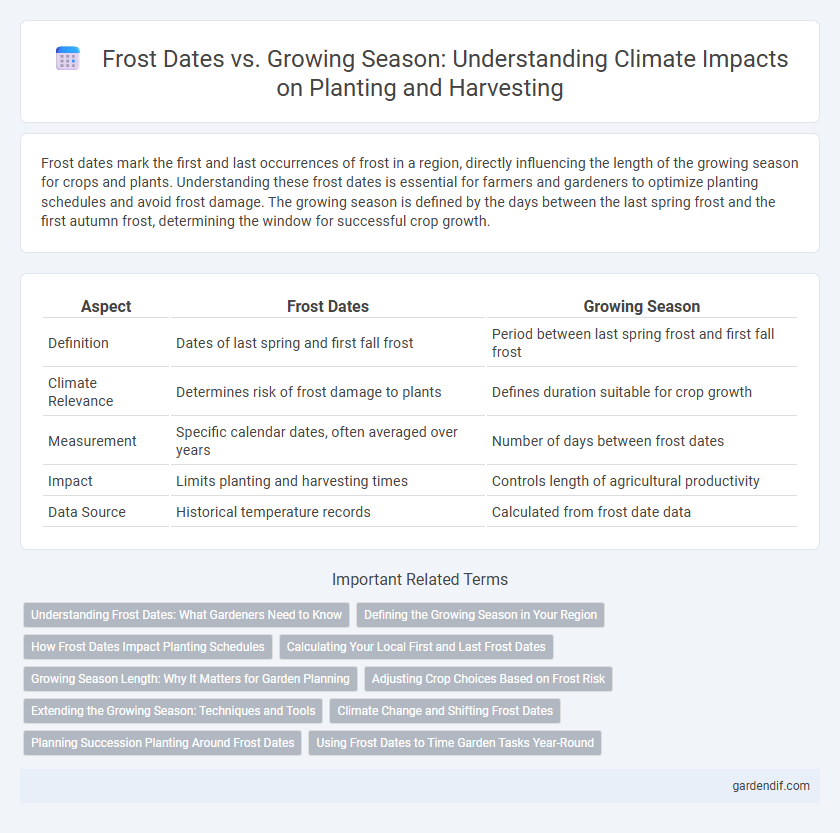
Frost Dates vs Growing Season Illustration
Frost dates mark the first and last occurrences of frost in a region, directly influencing the length of the growing season for crops and plants. Understanding these frost dates is essential for farmers and gardeners to optimize planting schedules and avoid frost damage. The growing season is defined by the days between the last spring frost and the first autumn frost, determining the window for successful crop growth.
Table of Comparison
| Aspect | Frost Dates | Growing Season |
|---|---|---|
| Definition | Dates of last spring and first fall frost | Period between last spring frost and first fall frost |
| Climate Relevance | Determines risk of frost damage to plants | Defines duration suitable for crop growth |
| Measurement | Specific calendar dates, often averaged over years | Number of days between frost dates |
| Impact | Limits planting and harvesting times | Controls length of agricultural productivity |
| Data Source | Historical temperature records | Calculated from frost date data |
Understanding Frost Dates: What Gardeners Need to Know
Frost dates mark the expected first and last occurrences of freezing temperatures that directly impact plant survival and growth cycles. Gardeners must track these dates to avoid planting seedlings before the risk of frost has passed, ensuring optimal growth during the growing season. Accurate knowledge of frost dates helps in selecting appropriate crops and timing protective measures against cold damage.
Defining the Growing Season in Your Region
Frost dates mark the beginning and end of safe planting periods by identifying the average last spring frost and first fall frost in your region, which directly influences the length of the growing season. The growing season is defined as the time span between these frost dates when temperatures stay consistently above 32degF (0degC), allowing crops to thrive without frost damage. Understanding local frost date data from sources like the USDA or National Weather Service helps gardeners and farmers optimize planting and harvesting schedules for maximum yield.
How Frost Dates Impact Planting Schedules
Frost dates mark the last and first expected occurrences of frost in a given region, directly influencing planting schedules by determining the safe window for seed sowing and transplanting. Understanding these dates helps gardeners and farmers avoid frost damage to sensitive crops, ensuring optimal growth periods within the growing season. Accurate frost date data enables the selection of appropriate crop varieties and timing, maximizing yield and minimizing crop loss.
Calculating Your Local First and Last Frost Dates
Calculating your local first and last frost dates requires analyzing historical temperature data specific to your region, typically found from local weather stations or agricultural extension services. These dates mark the average first and last occurrences of frost in spring and fall, defining the safe window for planting and harvesting sensitive crops. Accurately identifying these frost dates helps optimize the growing season length, improving garden planning and crop yield.
Growing Season Length: Why It Matters for Garden Planning
Growing season length directly influences the timing of planting and harvesting, determining the types of crops that can thrive in a particular climate zone. Understanding frost dates helps gardeners avoid damage from late spring or early fall frosts, optimizing growth periods and maximizing yield. Accurate knowledge of growing season duration improves resource allocation and supports sustainable garden management practices.
Adjusting Crop Choices Based on Frost Risk
Frost dates directly impact the length of the growing season, guiding farmers in selecting crops that can mature before the first autumn frost or after the last spring frost. Adjusting crop choices based on local average frost dates minimizes the risk of frost damage, optimizing yield and reducing financial loss. Understanding regional frost risk allows for strategic planting schedules and the selection of frost-tolerant crop varieties crucial for sustainable agriculture.
Extending the Growing Season: Techniques and Tools
Extending the growing season beyond traditional frost dates involves using techniques such as row covers, cold frames, and high tunnels to protect plants from early and late frosts. These tools create microclimates that maintain higher temperatures, allowing crops to germinate and mature earlier or later than usual. Implementing season extension methods increases yield potential and enhances year-round garden productivity despite climatic limitations.
Climate Change and Shifting Frost Dates
Shifting frost dates due to climate change are extending the growing season in many regions, altering traditional agricultural calendars. Warmer temperatures cause the last spring frost to occur earlier and the first fall frost to arrive later, impacting crop selection and planting schedules. These changes require farmers to adapt management practices to optimize yield while mitigating risks associated with unpredictable weather patterns.
Planning Succession Planting Around Frost Dates
Frost dates mark the critical thresholds for planting schedules, as early and late frosts can significantly impact crop survival and yield. Understanding the average last spring frost and first fall frost allows gardeners to accurately estimate the growing season length, optimizing succession planting intervals. By strategically timing plantings between frost dates, it is possible to extend harvest periods and maximize garden productivity while minimizing frost damage risks.
Using Frost Dates to Time Garden Tasks Year-Round
Using frost dates to time garden tasks year-round ensures optimal plant health by avoiding cold damage during sensitive growth phases. The last spring frost date and first fall frost date define the growing season length, guiding seed starting, transplanting, and harvest schedules. Accurate local frost date data enhances crop yield by aligning planting windows with safe temperature ranges.
Frost Dates vs Growing Season Infographic

 gardendif.com
gardendif.com